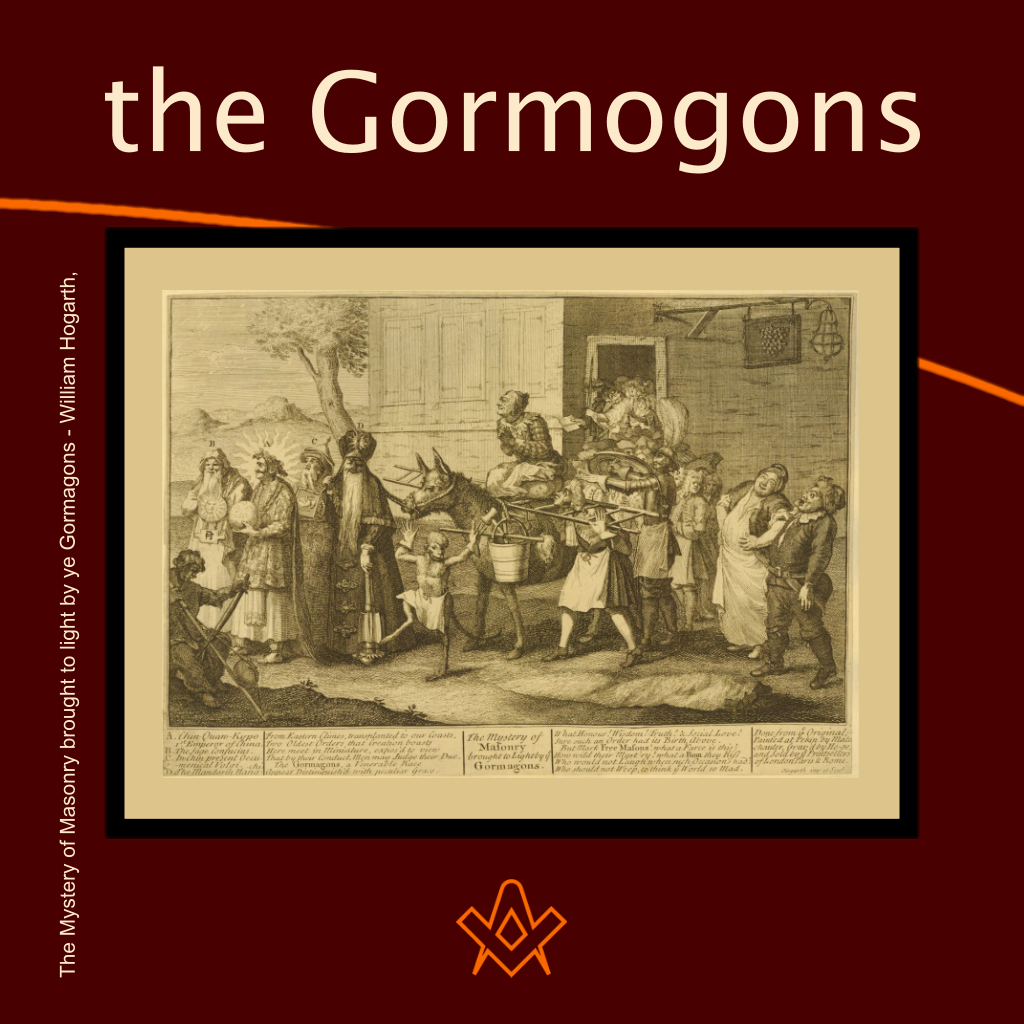The Antient Noble Order of the Gormogons had a brief existence in the eighteenth century; they left few records or accomplishments, and there is no indication as to their true purpose other than to parody and degrade Freemasonry, and perhaps further the Jacobite cause.
Rev. A. F. A. Woodford, editor of Kenning’s Masonic Cyclopaedia, described it as;

a secret and ridiculous society, which was established about 1724, in opposition to and ridicule of Freemasonry
The first communication of the Gormogons was published in the London Daily Post on 3 September 1724:
Whereas the truly ANTIENT NOBLE ORDER of the Gormogons, instituted by Chin-Qua Ky-Po, the first Emperor of China (according to their account), many thousand years before Adam, and of which the great philosopher Confucious was Oecumenicae Volgee, has lately been brought into England by a Mandarin, and he having admitted several Gentlemen of Honour into the mystery of that most illustrious order, they have determined to hold a Chapter at the Castle Tavern in Fleet Street, at the particular request of several persons of quality.
This is to inform the public, that there will be no drawn sword at the Door, nor Ladder in a dark Room, nor will any Mason be reciev’d as a member till he has renounced his Novel Order and been properly degraded. N.B. — The Grand Mogul, the Czar of Muscovy, and Prince Tochmas are entr’d into this Hon. Society; but it has been refused to the Rebel Meriweys, to his great Mortification.
The Mandarin will shortly set out for Rome, having a particular Commission to make a Present of the Antient Order to his Holiness, and it is believ’d the whole Sacred College of Cardinals will commence Gormogons.
Notice will be given in the Gazette the Day the Chapter will be held.
This instantly set the scene that this new ‘Society’ was firstly, rather eccentric, and secondly, having an immediate poke at Freemasonry.
It purported to be descended from an ancient society in China, founded by the first Emperor of China Chin-Qua Ky-Po, and Confucius as their original Oecumenicae Volgee (Grand Master).
A mysterious ‘Mandarin’ then travelled to England and admitted several ‘Gentlemen of Honour’ into their ‘most illustrious order’.
The word ‘Gormogon’ is – according to The Freemason (Nov. 16, 1895) – a ‘compound Chinese word consisting of “Gor”, signifying “Brother or Friend”; “Mo”, a “word of Eminence”; and “Gon”, signifying “Antiquity”, or that the province of “Mo-Gon”, in China, denotes “The Most Excellent and Most Ancient Kingdom”’.
Other sources have variants of the etymology of the name. In Cassell’s Dictionary of Slang it states that the word is a contraction of ‘gorgon’ and ‘dragon’, whereas the Oxford English Dictionary describes it as ‘meaningless: pseudo Chinese’.
In the humorous 1811 Dictionary of the Vulgar Tongue, the word ‘gormagon’ [note the variant spelling] is listed as:
A monster with six eyes, three mouths, four arms, eight legs, five on one side and three on the other, three arses, two tarses [penises], and a *** upon its back; a man on horseback, with a woman behind him.
No Freemason was welcome to join until he had ‘renounced his Novel Order and been properly degraded’, something that was reiterated in several articles which followed: one on Monday 14 September in which an article and then several letters appeared in The Plain Dealer.
But the fullest account of the Order is given in the second edition of the Grand Mystery of the Freemasons Discovered, published October 28th, 1724. Robert Freke Gould states in his Concise History of Freemasonry (1904), that the text contained:
‘Two Letters to a Friend—the first, concerning the Society of Free Masons; the second, giving an Account of the most Ancient Order of Gormogons’.
In the latter, Verus Commodus—whose signature is attached to both—observes, ‘I cannot guess why so excellent and laudable a Society as this of the GORMOGONS, should think it worth their while to make it an Article to exclude the Free-Masons. . . .
Except there be any Truth in what I have heard reported. . . . The Report is this.
That the Mandarin [Hang Chi] has declared, that many years since. Two unhappy busy persons who were Masons [Anderson and Desaguliers], having obtruded their idle Notions [Book of Constitutions] among the Vulgar Chineze, of Adam, and Solomon, and Hiram . . . being Crafts-men of their Order; and having besides, deflower’ d a venerable OLD Gentlewoman [taken unwarrantable Hberties with the Operative Charges and Regulations], under the Notion of making her an European HIRAMITE (as they call’d it) . . . they were hang’d Back to Back, on a gibbet. . . . And ever since, it has been an Article among the Gormogons, to exclude the Members of that Society, without they first undergo a solemn Degradation. …
If ever you hear from me again on this subject, it will be in a few REMARKS on that empty Book called The Constitutions, etc., of the Free-Masons, written, as I am told, by a Presbyterian Teacher, and pompously recommended by a certain Orthodox, Tho’ Mathematical Divine.”
Then, a few months later in the British Journal (December 12, 1724) this missive appeared:
We hear that a Peer of the first Rank, a noted Member of the Society of Free-Masons, hath suffered himself to be degraded as a member of that Society, and his Leather Apron and Gloves to be burnt, and thereupon enter’d himself as a Member of the Society of Gormogons, at the Castle-Tavern in Fleet Street.

Portrait of Philip Wharton, 1st Duke of Wharton (1698-1731)
IMAGE LINKED: wikimedia Attribution 4.0 International (CC BY 4.0)
The reference to ‘a peer of the first rank, a noted Member of the Society of Free-Masons’ is believed to be Philip, Duke of Wharton (21 December 1698 – 31 May 1731).
Wharton was a politician with strong Jacobite leanings. He was held to be the founder of one of the notorious Hellfire Clubs in London, a satirical gentleman’s club, which mocked religion and upheld the trend of blasphemy that was engulfing Britain at the time.
Wharton also founded an offshoot of the Hellfire club based in Twickenham – called The Schemers – which leaned more towards debauchery than blasphemy.
In 1721, the clubs were disbanded at the behest of King George I, who, influenced heavily by Wharton’s political enemy Robert Walpole, announced a bill against immorality specifically aimed at the Hellfire Club.
After the club disbanded Wharton leapfrogged his Masonic offices to become the Grand Master of the Premier Grand Lodge of England, not bad for a chap who had never been the Master of his own lodge at the King’s Arms near St Pauls.
On 21 June 1722, he was elected as the sixth Grand Master, with Dr John Desaguliers as his Deputy and James Anderson as Grand Warden.
The following year Wharton attempted to extend his position but was thwarted; thereafter ties with Grand Lodge were cut and relationships soured.
Poet and satirist Alexander Pope wrote this of Wharton:
 Wharton, the scorn and wonder of our days,
Wharton, the scorn and wonder of our days,
Whose ruling passion was the lust of praise…
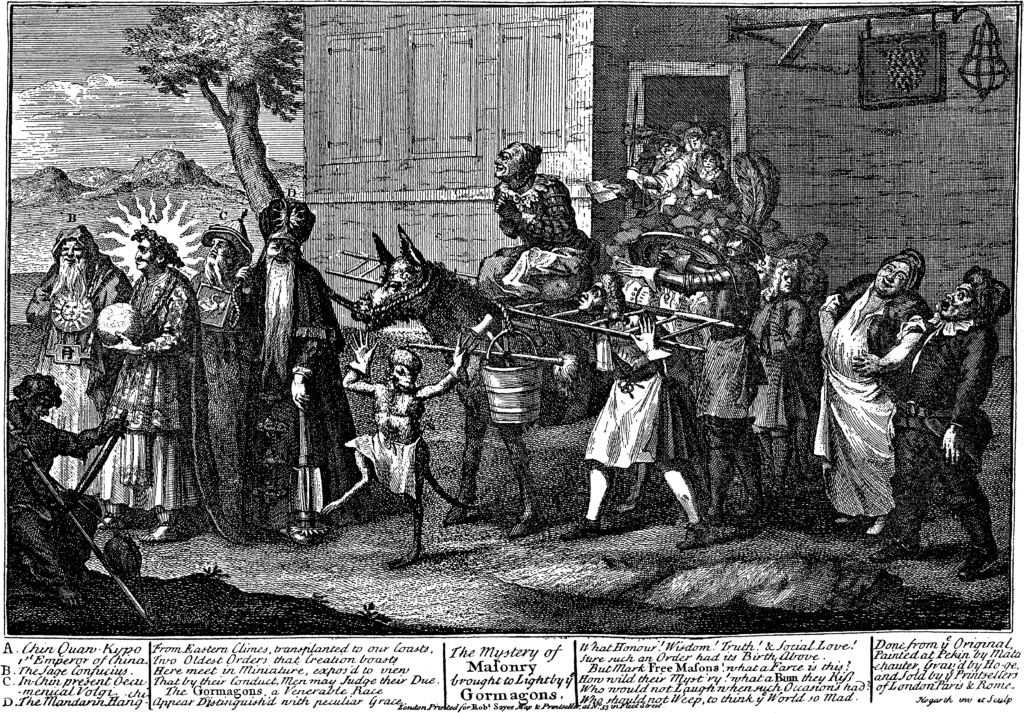
The Mystery of Masonry brought to light by ye Gormagons after William Hogarth
IMAGE LINKED: wikimedia Attribution 4.0 International (CC BY 4.0)
The cartoon featured above was by the prolific artistic satirist, and Freemason, William Hogarth (1697-1764).
Entitled ‘The Mystery of Masonry brought to light by ye Gormagons’, it featured some extraordinary caricatures of which it is believed that ‘the figure with his head through a ladder may be intended to be James Anderson; the figure in armour, Philip, Duke of Wharton; and the figure on the ass is perhaps John Desaguliers’ (from ‘William Hogarth and his Fraternity’, AQC. lxxvii (1964) pp. 14-18).
It was generally surmised that Wharton was behind the Gormogons, fuelled by his humiliation by, and subsequent disgust, of the Freemasons. The Freemason magazine of Nov 16, 1895, stated that:
…the Order of the Gormogons was his [Wharton’s] creation ; or, if not , that finding it a society already organised to his band , he made use of it to inflict as much damage and ridicule as possible upon the Freemasons, and at the same time to win all the support in his power for the Jacobite cause, of which from about the year 1724 till his death in 1731, he was the confirmed adherent.
The Grandmaster (or Oecumenical Volgee) was Chevalier Andrew Michael Ramsay of Ayr, Scotland, a Jacobite of strong convictions. There were theories by Robert Freke Gould and a Dr Kloss that the Gormogons held several political and religious intentions:
I. That the (Ecumenical Volgee was no less than the Chevalier RAMSAY, then at Rome in attendance upon the Young Pretender;
II, That the movement was a deeply-laid scheme on the part of the Jesuits to obtain certain ends ;
III. That in the Gormogons we meet with the precursors of the Schismatic Masons or ‘Ancients’.
Whatever their machinations, the Order was not successful and little more was heard from the Gormogons after 1728, when Wharton wrote a piece in Mist’s Journal. This came a year after he had been charged with High Treason for supporting the King of Spain during the 1727 siege of Gibraltar.
Wharton could not return to England for fear of being put on trial and he passed away on 31 May 1731. After this date there was no more mention of the Antient and Noble Order of the Gormogons being in existence.
There are however, a very few Gormogon medals that still exist; one is at The Library and Museum of Freemasonry at Grand Lodge of England, Great Queen Street in London, and another displayed in the British Museum.
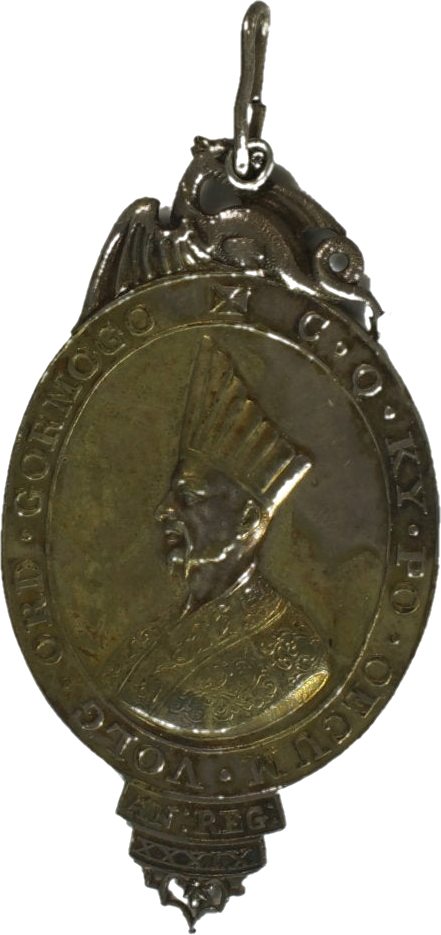
Gormogon Medal
IMAGE LINKED: wikimedia Attribution 4.0 International (CC BY 4.0)
Another higher definition version of the medal in the British Museum
Image linked: https://www.britishmuseum.org/collection/object/C_MG-1039
Image copyright: of The British Museum
Gormogon Society; silver medal; oval; obverse; draped bust of Chinaman with high head-dress surrounded by legend: medal surmounted by dragon with loop for suspension in its mouth; projection at bottom with inscription; reverse: sun in its splendour with surrounding legend. Production date 1724-1725
In 1729, satirical poet Henry Carey published his Poems which included a piece entitled ‘The Moderator between the Freemasons and Gormogons’:
![]()
The Masons and the Gormogons
Are laughing at one another,
While all mankind are laughing at them,
Then why do they make such a pother?
They bait their hooks for simple gulls
And truth with bam they smother;
And when they’ve taken in their culls,
Why then ’tis welcome brother.
Further Reading:
A Concise History of Freemasonry by Robert Freke Gould https://archive.org/details/cu31924030281459
The Life and Writings of Philip, Duke of Wharton by Lewis Melville, 1913 https://archive.org/stream/lifewritingsofph00benjuoft#page/n7/mode/2up

Philip, Duke of Wharton
Who was Philip, Duke of Wharton and was he Freemasonry’s Loose Cannon Ball ?
more….
Article by: Philippa Lee. Editor

Philippa Lee (writes as Philippa Faulks) is the author of eight books, an editor and researcher.
Philippa was initiated into the Honourable Fraternity of Ancient Freemasons (HFAF) in 2014.
Her specialism is ancient Egypt, Freemasonry, comparative religions and social history. She has several books in progress on the subject of ancient and modern Egypt. Selection of Books Online at Amazon
Recent Articles: masonic history
 Protestantism and Masonic Influence in Brazil Discover the untold story of how Freemasons helped Southern Americans immigrate to Brazil post-Civil War, fostering economic and educational growth in Santa Bárbara d’Oeste and Americana. Learn about their pivotal role in establishing Protestant churches and ensuring the secularity of the Brazilian State amidst a Catholic-dominated society. |
 Explore the proper use of the sacred word in Brazilian Freemasonry through an analysis of Masonic literature and Bible translations. Uncover the errors in pronunciation and the need for corrections to maintain liturgical coherence in rituals. Discover insights on Masonry, rituals, and the Hebrew word Boaz. |
 Narratives of History |
 A Very Royal Sesquicentenary |
 Unveiling the Enigma: Discover the Royal Society's Legacy and its Impact on Science. Delve into the fascinating history of the Royal Society, the prestigious UK academy shaping scientific progress since 1660. Explore its pivotal role in advancing knowledge, fostering collaboration, and unlocking the secrets of the universe. Prepare to be amazed! |
 Knights Templar in Freemasonry Uncover the Mysteries of the Knights Templar in Freemasonry! Delve into the intriguing world where chivalry and symbolism intertwine. Discover the captivating rituals and ancient secrets behind the Knights Templar Masonic Orders. Explore the historical connection and delve into the enigmatic narratives that continue to fascinate enthusiasts today. Unveil the hidden truths now! |
 The Royal Arch stands as the rainbow of promise in the Ritual; it stands as the promise of the resurrection; of that which was lost and that it shall be recovered. The question arises as to whether the Master's Word was originally communicated in the Third Degree? On this point there is some diversity of opinion. Originally published in 1915, this insight into the Fourth Degree – the Holy Royal Arch – is as relevant today as it was over 100 years ago. |
 Unveiling the Mysteries of Druidism: Discover the Intriguing Connection with Freemasonry. Explore the ancient spiritual practice of Druidism and its fascinating ties to the enigmatic world of Freemasonry. Delve into the shared symbolism and rituals that have captivated minds for centuries. Unlock the secrets of these intertwined traditions today! |
 Uncover the legacy of freestone masons and their pivotal role in crafting medieval cathedrals. Discover the artistry behind their techniques, the hierarchy within their craft, and the enduring impact of their intricate carvings. A deep dive into the world of these master craftsmen awaits you! |
 Unearth the intriguing journey from Vincha Culture to Freemasonry. Discover how ancient building methods intertwine with modern Masonic philosophies. This exploration will shed light on the fascinating link between the Serbian term "shestarenye" and the symbolic significance of the compass in Freemasonry. |
 Freemasonry and the Illuminati Unravel the enigmatic world of Freemasonry and the Illuminati in our latest exposé. Dive into centuries-old mysteries, debunk conspiracy theories, and discover the truth behind these elusive societies. Are they puppet masters or mere myths? Join us as we dissect history and fact from fiction. |
 The Île des Templiers, or “Island of the Templars” lies within a leafy park in Paris. The execution site of Jacques du Molay, the last Grand Master of the Knights’ Templar bears a plaque with the epitaph ‘A cet endroit / Jacques de Molay / Dernier grand maître / de l'ordre du temple / a été brûlé le 18 Mars 1314’ (‘In this location / Jacques de Molay / Last grand master / of the order of the temple / was burned on 18 March 1314’) |
 Operative Progressions to Speculative Masonry Both Operative and Speculative Masonry are an important part of the modern fraternity of Freemasonry, which combines elements of both traditions. Today, Freemasonry is a fraternity that is open to men of good character, who are interested in personal development and in making a positive contribution to their communities. |
 General Regulations of a Free Mason, 1723 General Regulations of a Free Mason as contained in Anderson's Constitutions of the Freemasons, published 1723. the Regulations are of great historical interest. Compiled by George Payne, the second Grand Master of the Premier Grand Lodge of England, they were printed in 1722/3, thus published just over five years after the formation of the Grand Lodge 1717. |
 The Genesis of the 1723 Book of Constitutions 2023, marks the three hundredth anniversary of the publication of the first printed Book of Constitutions of the Grand Lodge formally established in London two years previously. This is an anniversary whose significance extends beyond freemasonry. A paper by Andrew Prescott |
 The Ritual of the Operative Free Masons - P3 Existing Operative Free Masons. The ritual I am about to refer, is that of "The Worshipful Society of Free Masons, Rough Masons, Wallers, Slaters, Paviors, Plaisterers, and Bricklayers." By Thomas Carr, M.D., P. M. Honorary Member of the Guild of Operative Free Masons |
 Liberté chérie was a Masonic Lodge founded in 1943 by Belgian Resistance fighters and other political prisoners at Esterwegen concentration camp. It was one of the few lodges of Freemasons founded within a Nazi concentration camp during the Second World War. |
 The Ritual of the Operative Free Masons - P2 If anyone doubts the fact that the formation of Speculative Free Masonry was due to and based upon Operative Free Masonry, it is quite easy to convince him of his error if he will only study the first Book of Constitutions. By Thomas Carr, M.D., P. M. Honorary Member of the Guild of Operative Free Masons |
 In 1881, Freemasonry rose from the ashes of a fire in the mining town of Kokomo, Summit County, Colorado. Corinthian Lodge No. 42, along with Kokomo, no longer exists but it holds the record of having been – at an elevation of 10,618 feet – the highest Masonic Lodge in the USA. |
 The Huguenots and Early Modern Freemasonry The Huguenots influence in the development of early modern Freemasonry at the time of the formation of the Grand Lodge in London around 1717 / 1723. |
 November is a month of reflection – perhaps due to the fact that we are getting close to the years' end – but also because Remembrance / Armistice Day (11 November) is a significant date in most countries' diaries. |
 Speculative Freemasonry, as practise by Grand Lodge of England, was officially born just over three hundred years ago, is today an international organisation, counting over six million members. It has been subjected to persecution, suppression, and abolition throughout its history. In its infancy, only a couple of decades after its official birth, it had already become a target. |
 The Ritual of the Operative Free Masons - P1 The original paper was written, first, to prove that Speculative Free Masonry was derived from Operative Free Masonry; second, to give some account of the Operative Free Masons, of their Ritual, and of their customs. By Thomas Carr, M.D., P. M. Honorary Member of the Guild of Operative Free Masons |
 American Fraternalism in the 19th and Early 20th Centuries The late 19th and early 20th centuries in the United States has been called the "Golden Age of Fraternalism." How did this come about and why was the idea of joining a fraternal organization so popular? We will explore this question and examine the regalia used by many fraternal organizations in this period. |
 Societas Draconistarum, meaning "Society of the Dragonists"– was a chivalric Order for selected nobility, founded in 1408 by Sigismund von Luxembourg, who through marriage became the King of Hungary (1387–1437) and later Holy Roman Emperor. The Order was fashioned after the military orders of the Crusades, requiring its initiates to defend the cross and fight the enemies of Christianity, in particular the Ottoman Empire. |
 The Perjured Free Mason Detected Was Samuel Prichard a perjured individual, or simply a misguided Freemason? Prichard's book "Free Masonry Dissected" published in 1730, is now used by many Masonic historians as a source of reference with regards to the introduction of the third degree into the Craft. But at the time it was published in 1730, it was not so well received by members of the Grand Lodge of England. |
 17th century and the Holy Royal Arch This article focuses on a period of transition between a point in time when we can safely and historically identify the first formation of what could be called as the ‘Royal Arch’ and the historical events that have preceded it. |
 Most Freemasons have heard the terms 'Operative' and 'Speculative' Masons, and this article helps to understand the difference: |
 Roberts' Constitutions of Freemasonry 1722 Published a year before Anderson's Constitutions, The Old Constitutions Belonging to the Ancient and Honourable SOCIETY OF Free and Accepted MASONS. Originally printed in London England; Sold by J. Roberts, in Warwick-Lane, MDCCXXII.(1722) |
 From 'Songs of religion and life', 1876 by John Stuart Blackie (1809-1895) |
 On the Antiquity of Masonic Symbolism Is the Symbolism of Masonry an inheritance derived from the old Masons who flourished before the era of the Grand Lodges (1717); or has it been borrowed from the Rosicrucians or others, after 1717? |
 Mason's Marks – from Egypt to Europe? Mason's marks have been a source of intrigue, not only to Freemasons but to historians and archaeologists. The use of simple pictograms have been employed for millennia by artisans to identify their work. But where did they originate and why? |
 The White House Foundation Stones Further to the articles in our series on the history of the stone masons, we have a rather intriguing addition. During the 1950's renovation of the White House, President Truman retrieved more than 100 stone blocks with stonemasons marks. |
 What the Goose and Gridiron Tavern is in the ancient annals of London Freemasonry, The Green Dragon Tavern is to the memories of the Free-mason, of Boston and New England. |
 Auschwitz concentration camp: video photo article taken in 2013 |
 There are two things of importance happening this day - 27 January |
 Two approaches regarding the understanding of Freemasonry |
 Masonic Research in England c1930 An article which appeared in an American Masonic magazine, c1930 and which was reproduced in England, provoking a little controversy. |
 Masonic bookplates the ‘Brethren’s spiritual coats of arms and marks’ |
 The Unlawful Societies Act of 1799 Rebellious Freemasons and the 21st century |
 In 1912, Sarah Dowd of Dromore, Ireland, found a Masonic jewel dated 1517 - a date two hundred years before the establishment of Grand Lodge... |
 Freemasonry and Fascist Regime Interesting speech by the famous historian Prof. Aldo A. Mola, who links the fascist regime with the Masonic Associations. |
 Was famous Russian poet Alexander Pushkin a Freemason? And if so, was he a member of the lodge ‘for which all the lodges in Russia were destroyed’? |
 The Importance of Masonic Research Why is accurate - or authentic - Masonic research so important? The importance of making a daily advancement in Masonic knowledge is something that The Square is passionate about promoting. |
 The Antient Noble Order of the Gormogons had a brief existence in the eighteenth century; they left few records or accomplishments, |
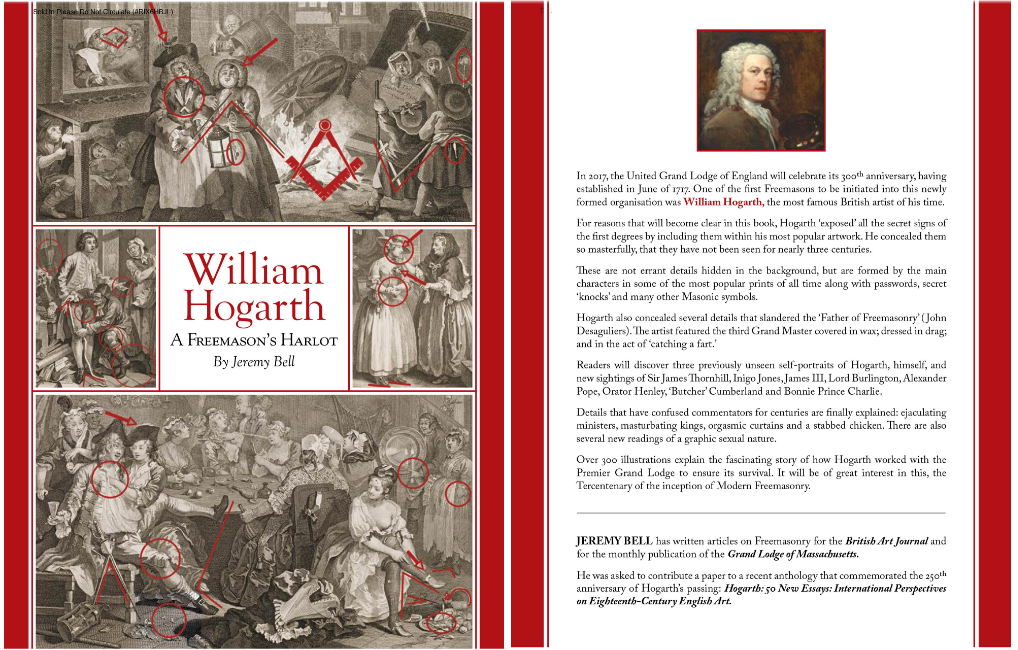
Many more details from the other scenes are explained in my book William Hogarth - A Freemason’s Harlot which is available from my website www.brotherhogarth.com.
Email me at Brotherhogarth@gmail.com. I can show you how many of Hogarth’s other works were Masonically themed.
Recent Articles: by Brother Hogarth
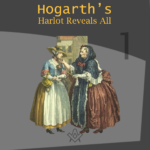 Hogarth’s Harlot Reveals All - Part 1 A new series looking at the hidden Masonic symbolism within Brother Hogarth's works - what can you find? |
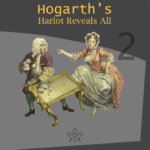 Hogarth’s Harlot Reveals All - Part 2 The second instalment in the series looking at the hidden Masonic symbolism within Brother Hogarth's works - what can you find? |
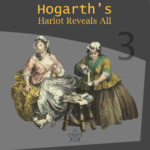 Hogarth’s Harlot Reveals All - Part 3 Brother Hogarth gives us another bawdy glimpse into the salacious world of the 'Harlot's Progress', and the tantalising Masonic symbolism hidden within! Can you spot the clues? |
 Hogarth’s Harlot Reveals All - Part 4 This month we find her in prison doing forced labour. So why, you may ask, is she dressed so finely? This sudden change of costume confused many commentators over the centuries. |
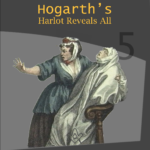 Hogarth’s Harlot Reveals All - Part 5 In last month’s instalment, our Harlot is found in prison doing forced labour. In this instalment the Harlot dies! |
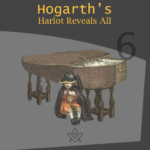 Hogarth’s Harlot Reveals All - Part 6 With our protagonist (the Harlot) lying in her casket, what next for the Widow's Son? |
 Hogarth's Harlot Reveals All - Part 6.2 A naughty clergyman, the virgin, and 'Father Time' - what can Hogarth reveal now?! |
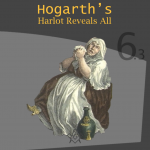 Hogarth's Harlot Reveals All - Part 6.3 Who are the famous men featured in the scene? Hogarth reveals all! |
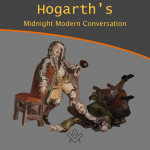 Hogarth's Midnight Modern Conversation Brother Hogarth is back with a look at another work of art with Masonic symbolism 'hidden in plain view' - what is occurring within the Midnight Modern Conversation? |
 Hogarth discreetly embeds more masonic signs and symbols in his paintings , never forgetting, everything he included in his scenes had meaning and is there for a reason. |
 Hogarth discreetly embeds more masonic signs and symbols in A Rake’s Progress, never forgetting, everything he included in his scenes had meaning and is there for a reason. |
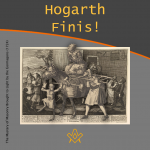 For twelve months Hogarth and his Harlot have revealed all, and the Rake has exposed himself. In this, the last part of the series (for now), we get a final glimpse at a few more of Hogarth's Masonic 'reveals'. |
masonic knowledge
to be a better citizen of the world
share the square with two brothers

click image to open email app on mobile device



